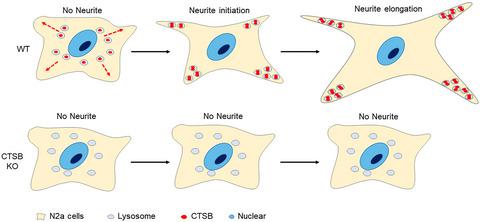当前位置:
X-MOL 学术
›
J. Neurochem.
›
论文详情
Our official English website, www.x-mol.net, welcomes your
feedback! (Note: you will need to create a separate account there.)
Cathepsin B inhibition blocks neurite outgrowth in cultured neurons by regulating lysosomal trafficking and remodeling.
Journal of Neurochemistry ( IF 4.2 ) Pub Date : 2020-04-24 , DOI: 10.1111/jnc.15032 Muzhou Jiang 1 , Jie Meng 2 , Fan Zeng 1 , Hong Qing 3 , Gregory Hook 4 , Vivian Hook 5 , Zhou Wu 1, 6 , Junjun Ni 1, 3
Journal of Neurochemistry ( IF 4.2 ) Pub Date : 2020-04-24 , DOI: 10.1111/jnc.15032 Muzhou Jiang 1 , Jie Meng 2 , Fan Zeng 1 , Hong Qing 3 , Gregory Hook 4 , Vivian Hook 5 , Zhou Wu 1, 6 , Junjun Ni 1, 3
Affiliation

|
Lysosomes are known to mediate neurite outgrowth in neurons. However, the principal lysosomal molecule controlling that outgrowth is unclear. We studied primary mouse neurons in vitro and found that they naturally develop neurite outgrowths over time and as they did so the lysosomal cysteine protease cathepsin B (CTSB) mRNA levels dramatically increased. Surprisingly, we found that treating those neurons with CA‐074Me, which inhibits CTSB, prevented neurites. As that compound also inhibits another protease, we evaluated a N2a neuronal cell line in which the CTSB gene was deleted (CTSB knockout, KO) using CRISPR technology and induced their neurite outgrowth by treatment with retinoic acid. We found that CTSB KO N2a cells failed to produce neurite outgrowths but the wild‐type (WT) did. CA‐074Me is a cell permeable prodrug of CA‐074, which is cell impermeable and a specific CTSB inhibitor. Neurite outgrowth was and was not suppressed in WT N2a cells treated with CA‐074Me and CA‐074, respectively. Lysosome‐associated membrane glycoprotein 2‐positive lysosomes traffic to the plasma cell membrane in WT but not in CTSB KO N2a cells. Interestingly, no obvious differences between WT and CTSB KO N2a cells were found in neurite outgrowth regulatory proteins, PI3K/AKT, ERK/MAPK, cJUN, and CREB. These findings show that intracellular CTSB controls neurite outgrowth and that it does so through regulation of lysosomal trafficking and remodeling in neurons. This adds valuable information regarding the physiological function of CTSB in neural development.
中文翻译:

组织蛋白酶 B 抑制通过调节溶酶体运输和重塑来阻止培养神经元中的神经突生长。
已知溶酶体介导神经元中的神经突生长。然而,控制这种生长的主要溶酶体分子尚不清楚。我们在体外研究了原代小鼠神经元,发现随着时间的推移,它们会自然地形成神经突生长,并且当它们这样做时,溶酶体半胱氨酸蛋白酶组织蛋白酶 B (CTSB) mRNA 水平急剧增加。令人惊讶的是,我们发现用抑制 CTSB 的 CA-074Me 治疗这些神经元可以预防神经突。由于该化合物还抑制另一种蛋白酶,我们使用 CRISPR 技术评估了 CTSB 基因被删除(CTSB 敲除,KO)的 N2a 神经元细胞系,并通过视黄酸处理诱导其神经突生长。我们发现 CTSB KO N2a 细胞无法产生神经突生长,但野生型 (WT) 细胞却可以。 CA-074Me 是 CA-074 的细胞渗透性前药,CA-074 是细胞不可渗透性的,是一种特异性 CTSB 抑制剂。分别用 CA-074Me 和 CA-074 处理的 WT N2a 细胞中,神经突生长受到抑制和未被抑制。溶酶体相关膜糖蛋白 2 阳性溶酶体在 WT 中转运至浆细胞膜,但在 CTSB KO N 2 a 细胞中则不然。有趣的是,WT 和 CTSB KO N2a 细胞之间的神经突生长调节蛋白、PI3K/AKT、ERK/MAPK、cJUN 和 CREB 没有发现明显差异。这些发现表明,细胞内 CTSB 控制神经突生长,并且它是通过调节神经元中的溶酶体运输和重塑来实现的。这增加了有关 CTSB 在神经发育中的生理功能的有价值的信息。
更新日期:2020-04-24
中文翻译:

组织蛋白酶 B 抑制通过调节溶酶体运输和重塑来阻止培养神经元中的神经突生长。
已知溶酶体介导神经元中的神经突生长。然而,控制这种生长的主要溶酶体分子尚不清楚。我们在体外研究了原代小鼠神经元,发现随着时间的推移,它们会自然地形成神经突生长,并且当它们这样做时,溶酶体半胱氨酸蛋白酶组织蛋白酶 B (CTSB) mRNA 水平急剧增加。令人惊讶的是,我们发现用抑制 CTSB 的 CA-074Me 治疗这些神经元可以预防神经突。由于该化合物还抑制另一种蛋白酶,我们使用 CRISPR 技术评估了 CTSB 基因被删除(CTSB 敲除,KO)的 N2a 神经元细胞系,并通过视黄酸处理诱导其神经突生长。我们发现 CTSB KO N2a 细胞无法产生神经突生长,但野生型 (WT) 细胞却可以。 CA-074Me 是 CA-074 的细胞渗透性前药,CA-074 是细胞不可渗透性的,是一种特异性 CTSB 抑制剂。分别用 CA-074Me 和 CA-074 处理的 WT N2a 细胞中,神经突生长受到抑制和未被抑制。溶酶体相关膜糖蛋白 2 阳性溶酶体在 WT 中转运至浆细胞膜,但在 CTSB KO N 2 a 细胞中则不然。有趣的是,WT 和 CTSB KO N2a 细胞之间的神经突生长调节蛋白、PI3K/AKT、ERK/MAPK、cJUN 和 CREB 没有发现明显差异。这些发现表明,细胞内 CTSB 控制神经突生长,并且它是通过调节神经元中的溶酶体运输和重塑来实现的。这增加了有关 CTSB 在神经发育中的生理功能的有价值的信息。











































 京公网安备 11010802027423号
京公网安备 11010802027423号